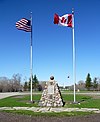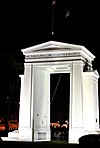Movements and activism

Pacifismedit
Pacifism is the categorical opposition to the behaviors of war or violence as a means of settling disputes or of gaining advantage. Pacifism covers a spectrum of views ranging from the belief that international disputes can and should all be resolved via peaceful behaviors; to calls for the abolition of various organizations which tend to institutionalize aggressive behaviors, such as the military, or arms manufacturers; to opposition to any organization of society that might rely in any way upon governmental force. Such groups which sometimes oppose the governmental use of force include anarchists and libertarians. Absolute pacifism opposes violent behavior under all circumstance, including defense of self and others.
Pacifism may be based on moral principles (a deontological view) or pragmatism (a consequentialist view). Principled pacifism holds that all forms of violent behavior are inappropriate responses to conflict, and are morally wrong. Pragmatic pacifism holds that the costs of war and inter-personal violence are so substantial that better ways of resolving disputes must be found.
Inner peace, meditation and prayerfulnessedit
Psychological or inner peace (i.e. peace of mind) refers to a state of being internally or spiritually at peace, with sufficient knowledge and understanding to keep oneself calm in the face of apparent discord or stress. Being internally "at peace" is considered by many to be a healthy mental state, or homeostasis and to be the opposite of feeling stressful, mentally anxious, or emotionally unstable. Within the meditative traditions, the psychological or inward achievement of "peace of mind" is often associated with bliss and happiness.
Peace of mind, serenity, and calmness are descriptions of a disposition free from the effects of stress. In some meditative traditions, inner peace is believed to be a state of consciousness or enlightenment that may be cultivated by various types of meditation, prayer, t'ai chi ch'uan (太极拳, tàijíquán), yoga, or other various types of mental or physical disciplines. Many such practices refer to this peace as an experience of knowing oneself. An emphasis on finding one's inner peace is often associated with traditions such as Buddhism, Hinduism, and some traditional Christian contemplative practices such as monasticism, as well as with the New Age movement.
Satyagrahaedit
Satyagraha is a philosophy and practice of nonviolent resistance developed by Mohandas Karamchand Gandhi. He deployed satyagraha techniques in campaigns for Indian independence and also during his earlier struggles in South Africa.
The word satyagraha itself was coined through a public contest that Gandhi sponsored through the newspaper he published in South Africa, 'Indian Opinion', when he realized that neither the common, contemporary Hindu language nor the English language contained a word which fully expressed his own meanings and intentions when he talked about his nonviolent approaches to conflict. According to Gandhi's autobiography, the contest winner was Maganlal Gandhi (presumably no relation), who submitted the entry 'sadagraha', which Gandhi then modified to 'satyagraha'. Etymologically, this Hindic word means 'truth-firmness', and is commonly translated as 'steadfastness in the truth' or 'truth-force'.
Satyagraha theory also influenced Martin Luther King Jr. during the campaigns he led during the civil rights movement in the United States. The theory of satyagraha sees means and ends as inseparable. Therefore, it is contradictory to try to use violence to obtain peace. As Gandhi wrote: "They say, 'means are, after all, means'. I would say, 'means are, after all, everything'. As the means so the end..." A contemporary quote sometimes attributed to Gandhi, but also to A. J. Muste, sums it up: 'There is no way to peace; peace is the way.
Monumentsedit
The following are monuments to peace:
| Name | Location | Organization | Meaning | Image |
|---|---|---|---|---|
| Japanese Peace Bell | New York City, NY | United Nations | World peace | 
|
| Fountain of Time | Chicago, IL | Chicago Park District | 100 years of peace between the US and UK | 
|
| Fredensborg Palace | Fredensborg, Denmark | Frederick IV | The peace between Denmark–Norway and Sweden, after Great Northern War which was signed 3 July 1720 on the site of the unfinished palace. | 
|
| International Peace Garden | North Dakota, Manitoba | non-profit organization | Peace between the US and Canada, World peace | 
|
| Peace Arch | border between US and Canada, near Surrey, British Columbia. | non-profit organization | Built to honour the first 100 years of peace between Great Britain and the United States resulting from the signing of the Treaty of Ghent in 1814. | 
|
| Statue of Europe | Brussels | European Commission | Unity in Peace in Europe | 
|
| Waterton-Glacier International Peace Park | Alberta, Montana | non-profit organization | World Peace | 
|
| Japanese Garden of Peace | Fredericksburg, Texas | National Museum of the Pacific War | A gift from the people of Japan to the people of the United States, presented to honor Chester W. Nimitz and created as a respite from the intensity of violence, destruction, and loss. | 
|
| The Peace Dome | Windyville, MO | not-for-profit organization | Many minds working together toward a common ideal to create real and lasting transformation of consciousness on planet Earth. A place for people to come together to learn how to live peaceably. | |
| Shanti Stupa | Pokhara, Nepal | Nipponzan-Myōhōji-Daisanga | One of eighty peace pagodas in the World. |
Comments
Post a Comment